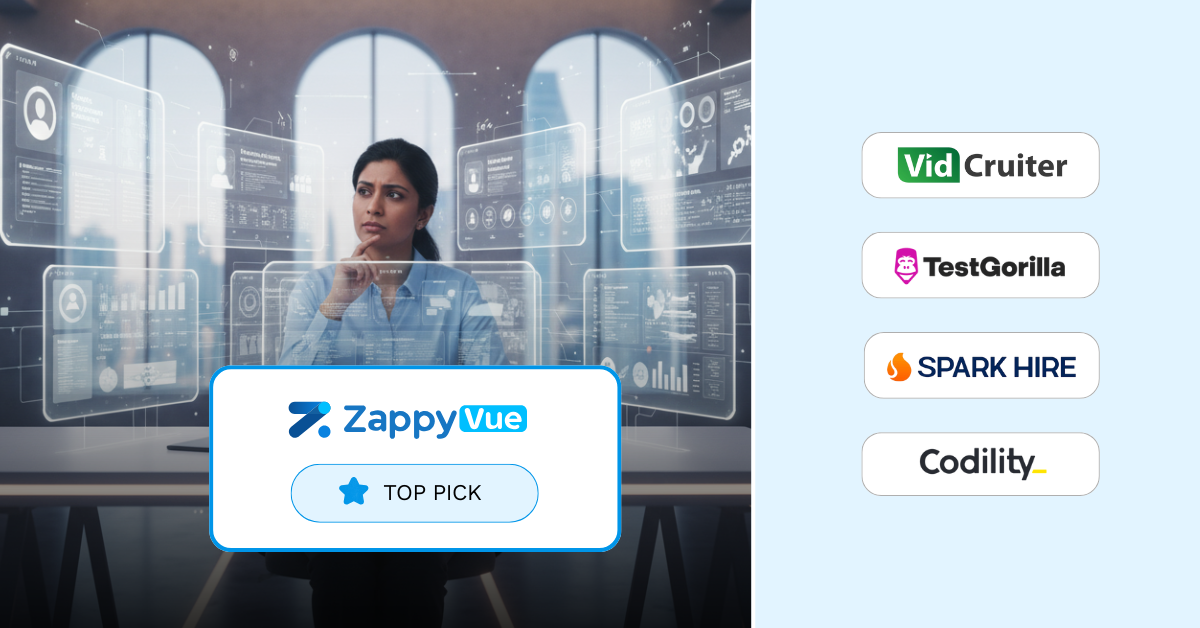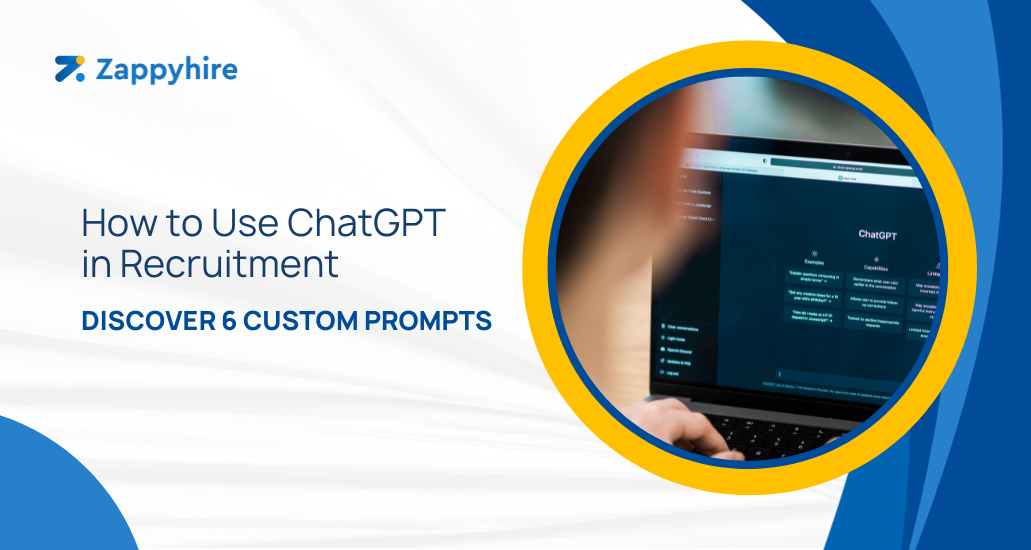
ChatGPT has been the talk of the town this week – and we’re here to break down the ways in which you, as a recruiter or an HR professional, can make the best use of it!
So, what exactly is ChatGPT?
ChatGPT is a large language model trained by OpenAI. Its function is to assist with language-related tasks, such as providing information, answering questions, and generating text based on the input it receives from you.
It is a virtual assistant that is able to provide answers and guidance on a wide range of topics, including recruitment and HR!
Is ChatGPT useful for recruiters and HR professionals?
While ChatGPT is not specifically made for recruitment or HR activities, we’ve discovered that it does help in a variety of ways!
Language Translation – Communicate with international candidates by translating emails and messages.
Job Posting Variations – Generate multiple versions of job postings to test which one attracts more qualified applicants.
Resume Summaries – Quickly summarize lengthy resumes into concise one-pagers for easier evaluation.
Engaging Passive Candidates – Compose compelling messages to initiate conversations with passive candidates and highlight the value they bring to the organization.
Salary Negotiation Scripts – Create scripts to guide salary negotiations with candidates, ensuring a fair and transparent process.
Company Culture Descriptions – Create engaging descriptions of your company culture to attract candidates who resonate with your values.
LinkedIn Outreach – Generate LinkedIn messages that stand out and pique the interest of potential candidates.
How to ask questions in ChatGPT?
You can simply type your query out and submit it through the interface.
It can be helpful to phrase your question clearly and concisely, and to include any relevant details or context. This will allow ChatGPT to better understand what you are asking and provide a more accurate and helpful response.
If you are not sure how to phrase your question or are having trouble communicating your question effectively, ask for clarification or ask for help in rephrasing your question. The application will churn out answers until you’re satisfied with it.
6 ways to use ChatGPT for recruitment (practical use cases)
Unlike its predecessors, ChatGPT goes beyond simplistic responses and engages users with in-depth information and human-like conversations. It doesn’t just provide regurgitated information from search engines but crafts informed responses based on its extensive knowledge base.
This unique capability places ChatGPT in direct competition with traditional search engines – such is the distinctiveness of ChatGPT!
1. Candidate outreach for a specific role
ChatGPT can assist in composing candidate outreach emails that focus on the skills and experience you’re looking for in a candidate. When you’re targeting a specific role, reaching out to potential candidates with tailored messages can be a game changer.
Prompt - "Compose a candidate outreach email for an experienced project manager, emphasizing their [relevant skill/experience]."
These personalized outreach emails are designed to catch the attention of potential candidates by highlighting the specific qualifications that make them an ideal fit for the position. They demonstrate your organization’s commitment to finding the right talent.
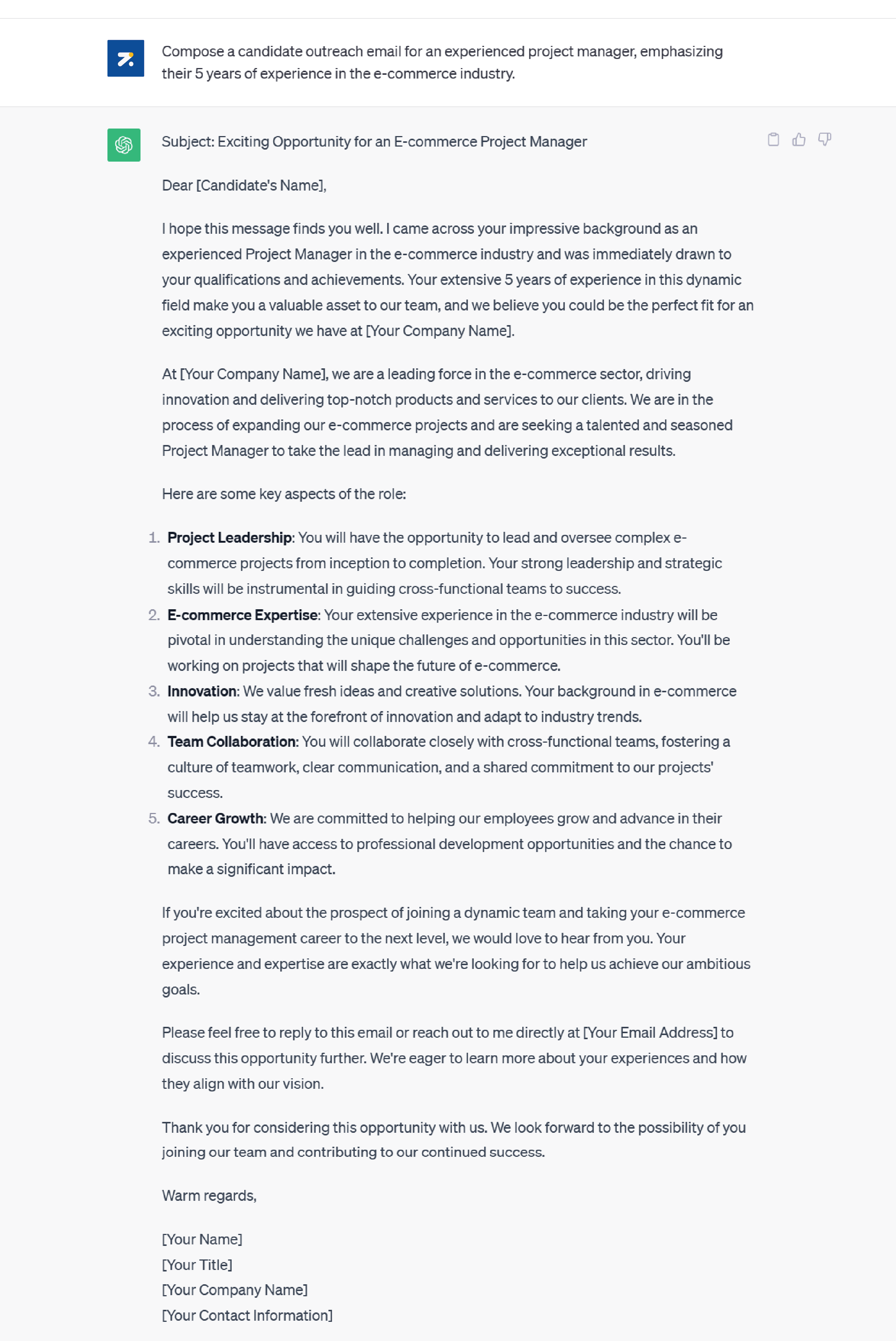
2. Ready-to-publish job descriptions
When you’re tasked with drafting a job description that attracts top talent, making them customized is pivotal in attracting candidates who possess the specific skillset you’re looking for.
We instructed ChatGPT to create a job description tailored to a specific role, and the result was a comprehensive job description that encapsulated the position’s intricacies.
Prompt - "Create a unique job description tailored for a [job position] with experience in [tool/skill]"
However, to truly stand out, it is advisable to personalize job advertisements, emphasizing your unique employer brand, company mission, values, and tone.
An alternative approach is to utilize ChatGPT to create a job ad outline, filling in specific details under various headings.
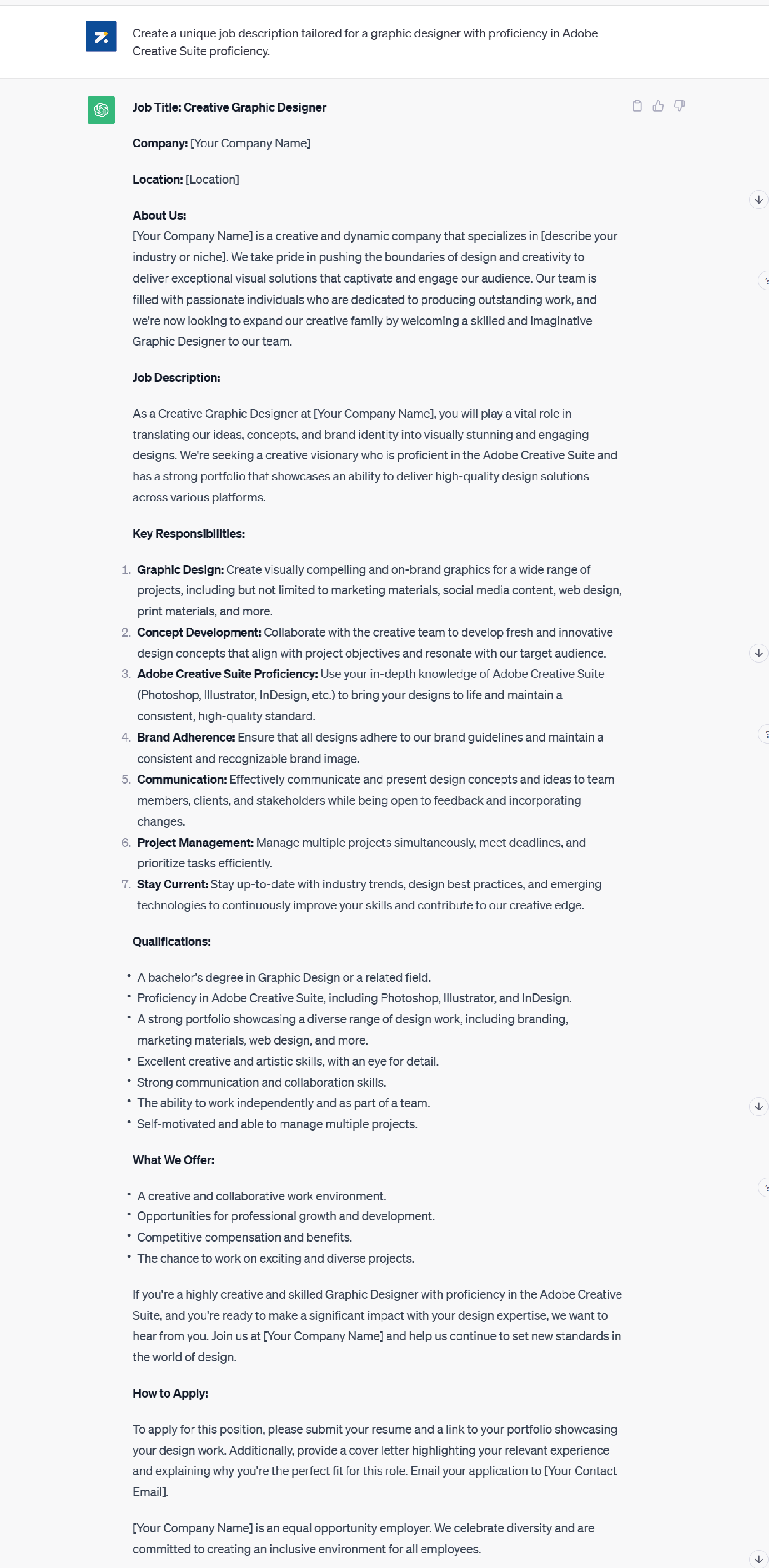
3. Tailored interview questions
Once you’ve perfected your job descriptions, the next step is to create a tailored set of interview questions.
As a recruiter, it can be exhausting to learn about a field every time you have to hire. But ChatGPT comes to the rescue with these questions that are precision-engineered for candidates applying for a specific role.
This ensures that your interview process aligns perfectly with the job requirements. This way, you can still research to get to know the basics of the field the position is open for – but it’ll significantly cut down the amount of stress.
Prompt - "Generate a set of interview questions tailored for candidates applying for the [job role] position at [your company name]. Here’s the job description"
These questions can help you delve into the core competencies and skills required for the position and help you gain insights into the candidate’s suitability for the role.
4. Creating rejection emails with empathy
Rejection is an inevitable part of the hiring process, but it can be handled with empathy and professionalism.
ChatGPT can assist in composing rejection emails that not only convey appreciation for the candidate’s application but also provide constructive feedback and encourage them to consider future opportunities with your organization.
Prompt - "Craft a compassionate candidate rejection email that conveys our appreciation for their application for the [position], and encourages them to consider future opportunities with us."
Rejection emails that showcase compassion are more likely to leave a positive impression on candidates, even when they aren’t selected.
They reflect your organization’s professionalism and empathy, potentially turning rejected candidates into future assets.
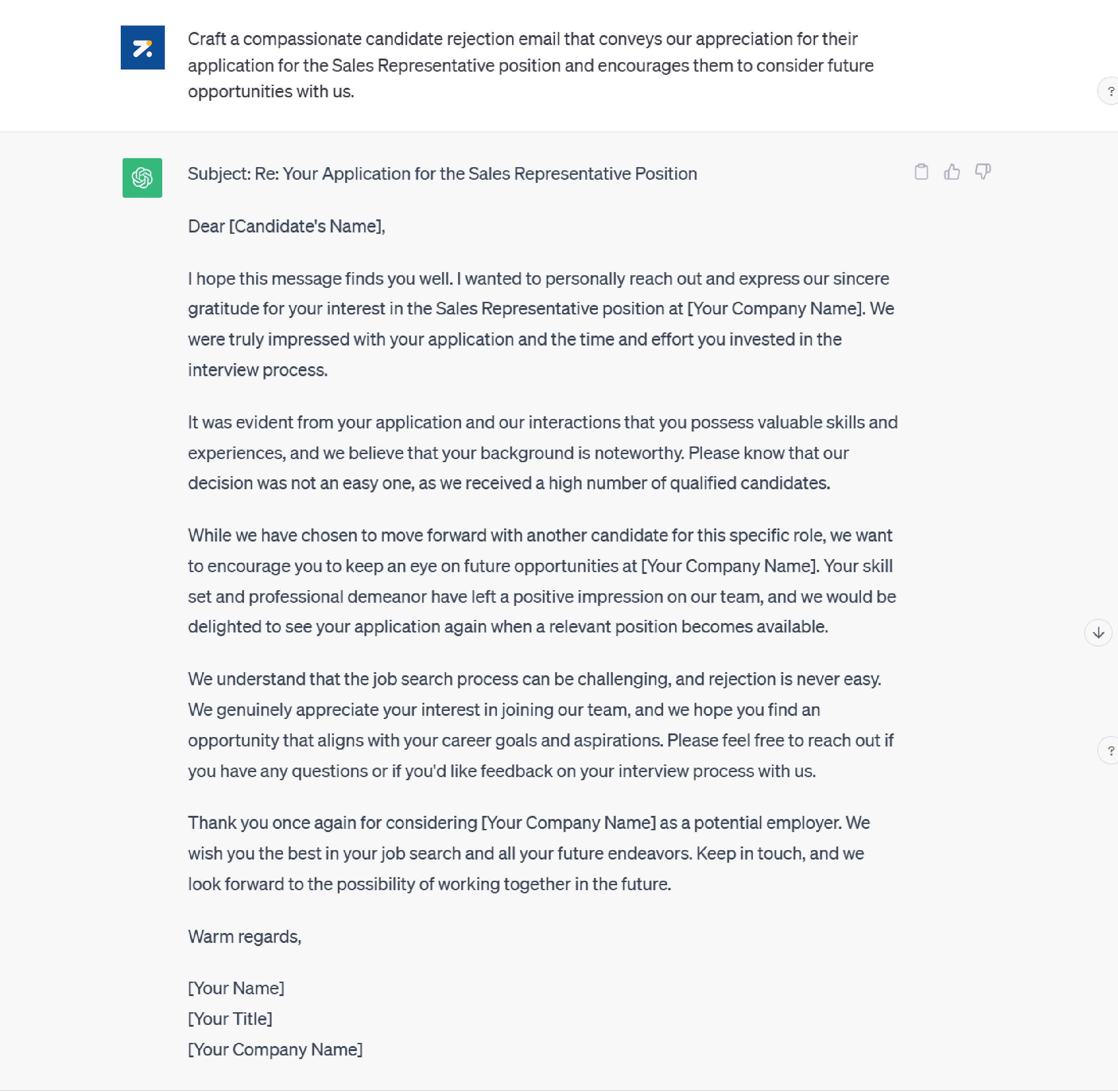
5. Employee onboarding for a specific department
Employee onboarding is a critical process for ensuring new hires integrate into your organization without a hitch.
ChatGPT can assist in developing onboarding plans tailored to specific departments. These plans include welcome messages, training schedules, and introductions to key team members.
Prompt - "Create an onboarding plan for new hires in the Sales Department, including a welcome message, training schedule, and introduction to key team members."
Customized onboarding plans ensure that new employees receive the right guidance and support as they begin their journey with your company.
This personalized approach sets the stage for long-term success and satisfaction among your team members.
6. Reaching passive candidates
Connecting with passive candidates can be a challenge, but ChatGPT can craft tailored messages that acknowledge their current employment status, highlight their skills, and establish a connection based on shared interests or connections.
These messages are designed to grab the attention of passive candidates and pique their interest in your job opportunities.
Prompt - "Create a compelling LinkedIn message to initiate a conversation with a passive candidate who is currently employed but possesses skills and experience [mention the skills/experience] relevant to our open position. Emphasize their unique qualities and how their expertise can make a difference in [your organization’s name]."
Remember to personalize the message further by including specific details about your organization and the role you are hiring for and mention any shared interests or connections to establish rapport and interest.
This will make it more likely to resonate with passive candidates and spark a conversation.
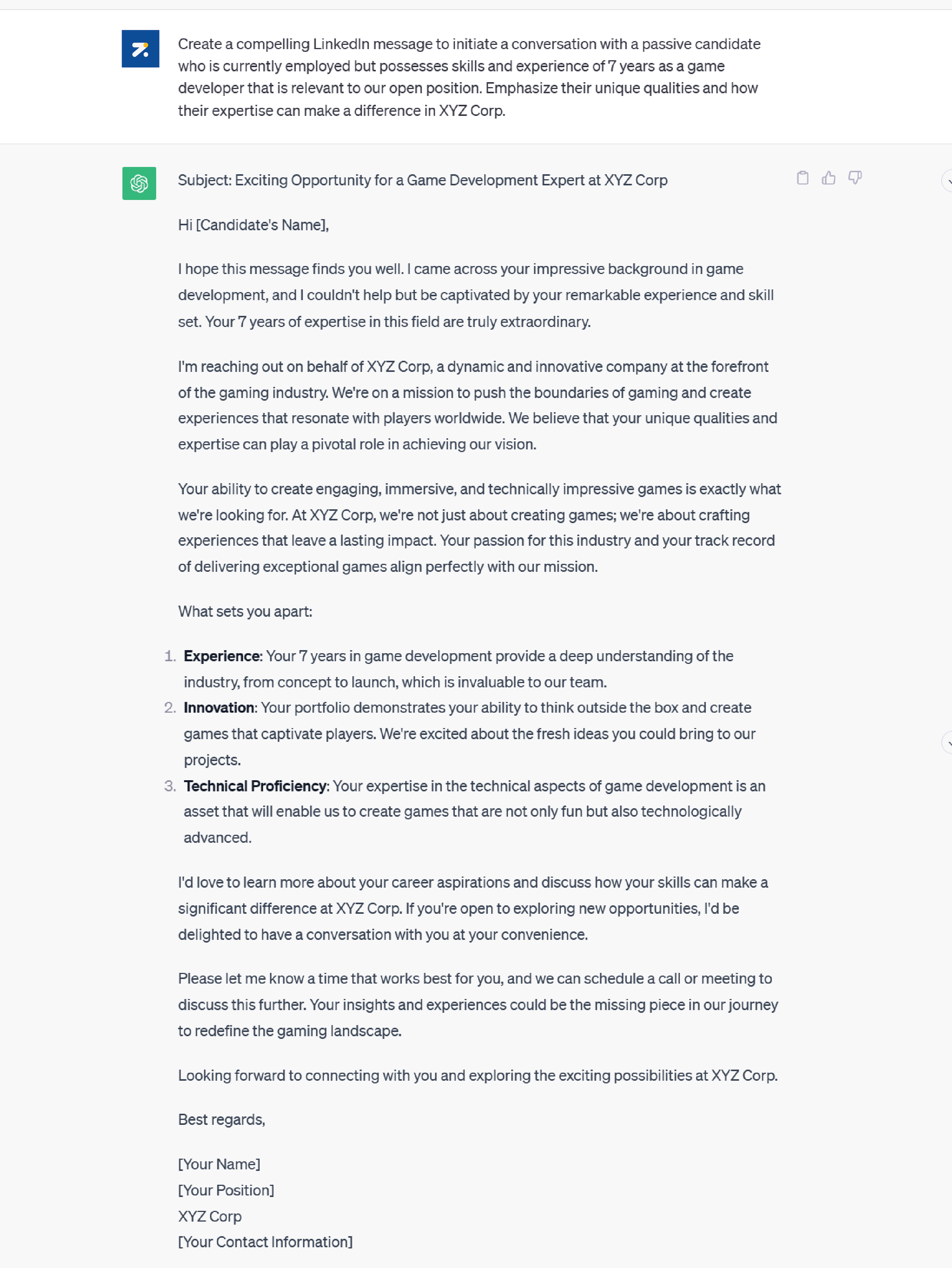
What are other top use cases for ChatGPT in recruitment?
The list can be endless, but we’ve compiled a list of more common ways by which recruiters across the world are utilizing ChatGPT.
| Your Need | ChatGPT Prompt | The Benefits |
| You aim to craft a precise Boolean search | “Write a Boolean search string to identify software engineers in [preferred location]. Include an OR statement with the most common front-end coding languages and an OR statement with the competitor companies.” | This is how you create accurate Boolean search strings to use in your ATS or Google X-Ray search. It simplifies your candidate search to pinpoint potential hires who meet your criteria. |
| You want to assess a candidate’s suitability | “Provide a list of pros and cons to assess this candidate. Here’s the resume and job description.” | When evaluating a candidate’s suitability, this prompt helps you generate a list of strengths and weaknesses. This allows a more structured and informed decision-making process during candidate assessment. |
| You aim to create an employer-brand EVP | “Craft an employer brand EVP for our company. Describe the unique benefits of working here, the company culture, and opportunities for growth. More details about our company are as follows…” | When building an employer brand, this prompt helps in creating a compelling Employer Value Proposition (EVP). It outlines the company’s unique advantages, culture, and growth prospects, which can be used in recruitment marketing. |
| You want to develop the company’s mission and values | “Generate a mission and values statement for our company. Highlight our core values and the mission we’re committed to. More details about our company are as follows…” | When defining your company’s mission and values, this prompt guides you in articulating the organization’s core principles and long-term mission. It provides a foundational statement to align your team and attract candidates who share these values. |
| You fancy a fun touch in recruitment advertising | “Create a catchy radio jingle for a recruitment advertisement for [your company’s name]. Keep it engaging and memorable.” | For a creative twist in recruitment marketing, this prompt helps you craft a unique radio jingle that adds a fun element to your advertising campaigns, making them more memorable to potential candidates. |
What questions will be relevant for recruiters and HR Managers to ask ChatGPT?
There is a range of questions that recruiters and HR managers could potentially ask ChatGPT in order to get helpful and accurate answers. Some examples include:
- How can I improve the efficiency of my recruitment process?
- What are the key recruitment metrics that I should track to measure the performance of my team?
- How can I identify the best candidates for a particular job opening?
- What are some common mistakes that recruiters and HR managers make, and how can I avoid them?
- How can I improve the candidate experience and increase the likelihood of successful hires?
- What are some best practices for conducting effective interviews with job candidates?
- How can I support remote and distributed recruitment teams and improve their collaboration and communication?
- What are some potential legal or compliance issues that I need to be aware of in the context of recruitment and HR?
- How can I stay up-to-date with the latest trends and developments in the field of recruitment and HR?
- What are some ways that I can support diversity and inclusion initiatives within my recruitment and HR processes?
- How can I create effective and engaging job descriptions that attract the best candidates?
- What are some common questions that job seekers ask during the recruitment process, and how should I respond to them?
- How can I use technology and automation to improve the efficiency and effectiveness of my recruitment and HR processes?
- What are some ways that I can use data and analytics to make better decisions in the context of recruitment and HR?
- How can I identify and address potential bias in my recruitment and HR processes?
- What are some ways that I can improve the onboarding process for new hires and ensure that they are successful in their new roles?
- How can I use social media and other online platforms to connect with potential candidates and promote job opportunities?
- What are some best practices for managing and developing a talented and engaged workforce?
- How can I stay competitive in the market for talent and ensure that my company is an attractive place to work?
- What are some ways that I can support the professional development and career growth of my team members?
And we tested it out!
Check out a couple of samples of the above-mentioned questions!
First, we asked a technical question – “How can I use technology and automation to improve the efficiency and effectiveness of my recruitment and HR processes?”
And this was the output.
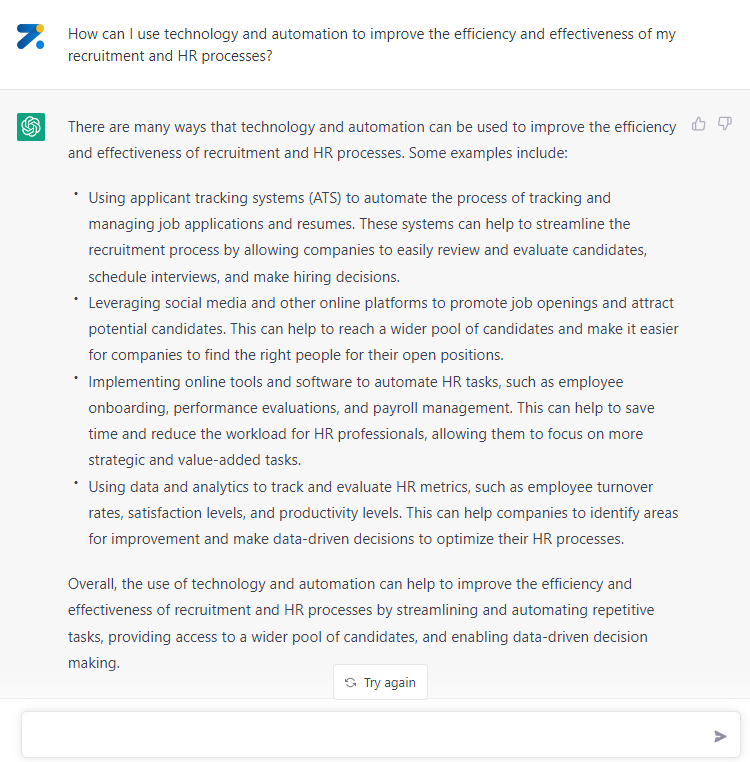
Then, we asked a general question – “How can I improve the candidate experience and increase the likelihood of successful hires?”
And this is what we got:
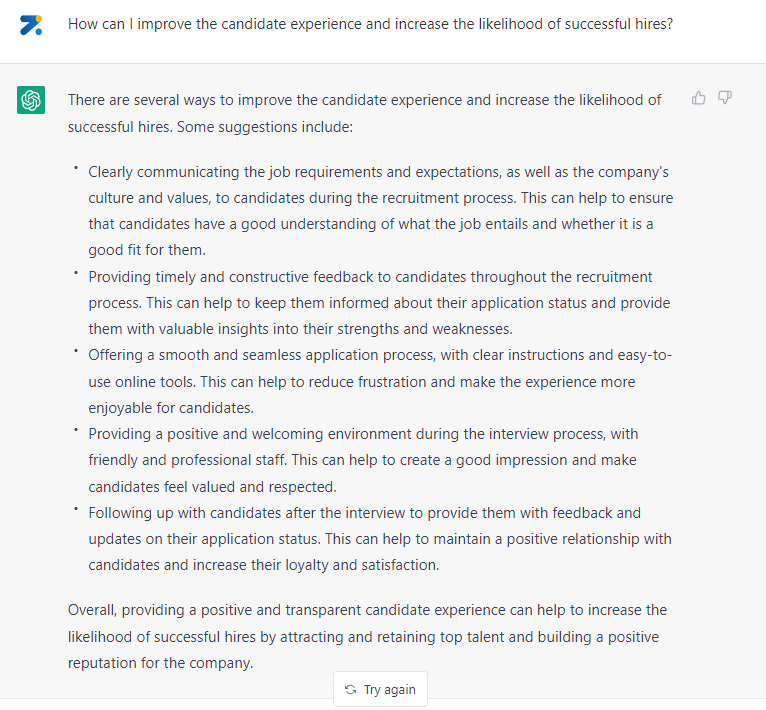
While it was not exhaustive, it’s a good starting point. Hence, as a follow-up, we asked the application for 4 more ways.
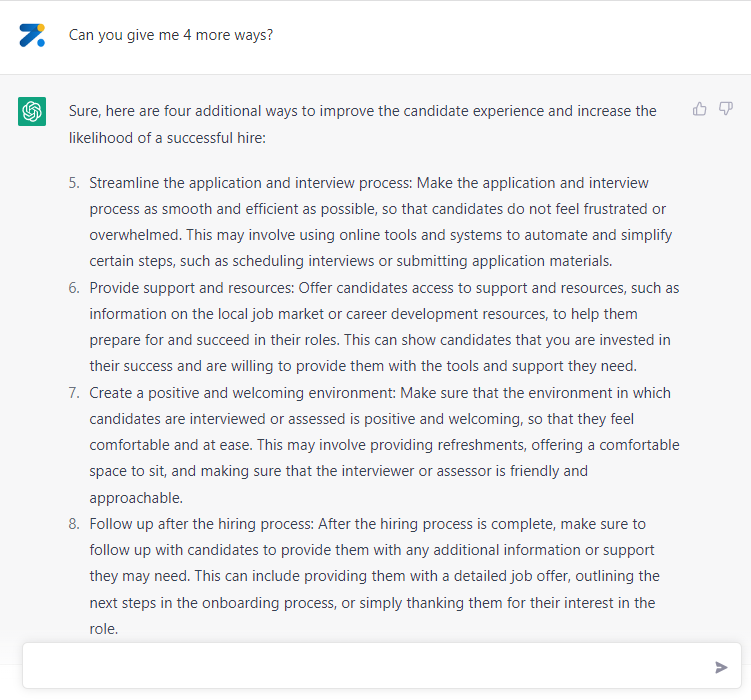
The output was pretty good and was only moderately repetitive. Overall, the answers ChatGPT produced were actionable.
How to ask follow-up questions to ChatGPT
Before asking a follow-up question, take a moment to make sure you have a good understanding of the answer to the initial question. This will help you to ask a more targeted and relevant follow-up question.
It can be helpful to clarify any unclear points or seek additional details by asking specific, targeted follow-up questions. For example, if you are not sure about something in the answer ChatGPT provided, you can ask for clarification by saying something like “Can you please explain more about X?” or “Could you give me an example of Y?”
You can also ask follow-up questions to explore related topics or seek more detailed information about a specific topic. For instance, you could say something like “That’s interesting. Can you tell me more about Z?” or “Could you provide more specifics about how X works?”
Limitations of ChatGPT
As of now, the application is free to use. Something to keep in mind while using ChatGPT is to not provide any sensitive or personal information. Furthermore, it may occasionally generate incorrect information, so don’t rely on the validity of ChatGPT’s output if you’re looking for factual information. In addition, it only has limited knowledge of world events after 2021.
Since ChatGPT is only a large language model, it does not have access to external information or the ability to browse the internet, so it can not provide specific information about people, events, or other topics that are not directly related to the input you give. Also, it can not perform actions or carry out tasks that go beyond its language processing capabilities, such as reviewing resumes or analyzing data – even if you feed it appropriate data.
So, what’s the best way forward, now that this large language model has also entered the HR tech fray?
Well, with its ability to assist in small content/idea-generating tasks, you can think of ChatGPT as a spunky intern! Among other things, HR interns assist in the recruiting process by creating job descriptions, developing HR policies, coming up with answers to employee queries, etc – and ChatGPT could assist in these tasks!
Pretty neat, isn’t it? Try it out and let us know if you find any more cool uses!
Speaking of optimizing new tech in recruitment and HR, did you know what’s proven to drastically improve your recruitment process and give you a massive ROI? Answer: an AI-powered ATS!
With Zappyhire as your trusted intelligent recruiting automation partner, we’re sure that you’ll find innovative ways to use ChatGPT, so that it’ll be complementary to your recruiting and HR efforts!




